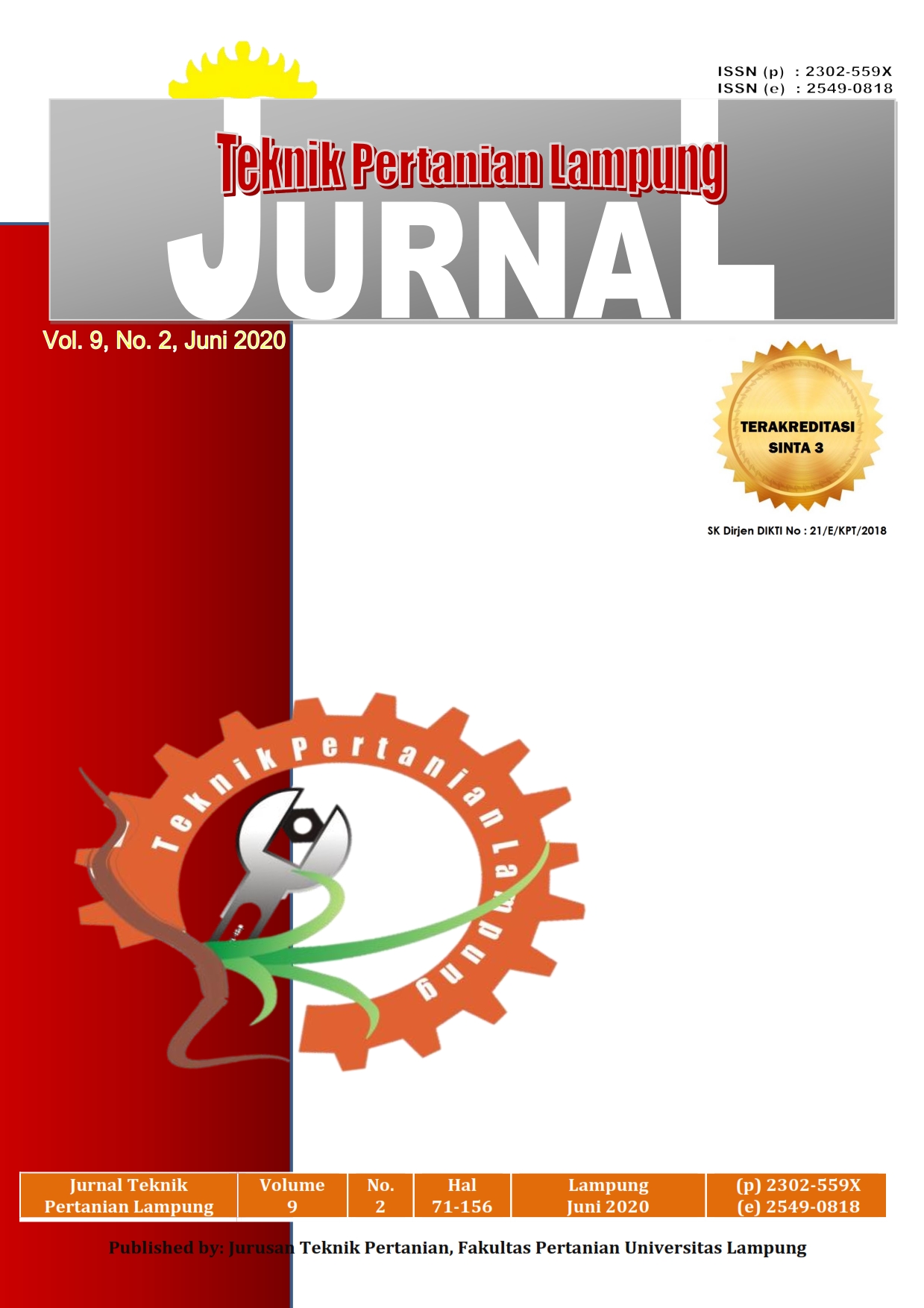PEMETAAN POTENSI BAHAYA BANJIR DI KABUPATEN MANOKWARI MELALUI PEMANFAATAN DATA GLOBAL PRECIPITATION MEASUREMENT (GPM) DAN ANALISIS BENTANG LAHAN
DOI:
https://doi.org/10.23960/jtep-l.v9i2.96-103Abstract
Rainfall data is the main parameter in flood analysis. The limited number of climate stations and rain stations in Manokwari due to low spatial representativeness of rainfall. This study aims to utilize Global Precipitation Measurement (GPM) as a satellite-based rainfall observer to analyze and floods hazard mapping in Manokwari. The method used in this research is landscape analysis. Research showed that almost all areas in Manokwari had high levels of flood hazard at any period except Tanah Rubuh district.
References
Anwari and Makruf, M. (2019) ‘Pemetaan Wilayah Rawan Bahaya Banjir di Kabupaten Pamekasan Berbasis Sistem Informasi Geografis (SIG)’, Jurnal Ilmiah NERO, 4(2), pp. 117–123.
Asong, Z. E. et al. (2017) ‘Evaluation of Integrated Multisatellite Retrievals for GPM ( IMERG ) over Southern Canada against Ground Precipitation Observations : A Preliminary Assessment’, Journal of Hydrometeorology, 18, pp. 1033–1050. doi: 10.1175/JHM-D-16-0187.1.
Azka, M. A. et al. (2018) ‘Uji Akurasi Produk Estimasi Curah Hujan Satelit GPM IMERG di Surabaya, Indonesia’, Jurnal Sains & Teknologi Modifikasi Cuaca, 19(2), pp. 83–88.
Badan Nasional Penanggulangan Bencana (2020) Bencana Menurut Wilayah Kabupaten/ Kota. Available at: http://bnpb.cloud/dibi/tabel2a (Accessed: 6 February 2020).
Badan Standardisasi Nasional (2015) Metode Pemetaan Rawan Banjir Skala 1:50.000 dan 1:25.000. 1st edn. Jakarta: Badan Standardisasi Nasional.
BMKG (2018) Metadata Stasiun. Available at: https://dataonline.bmkg.go.id/home (Accessed: 28 February 2018).
Chen, Z. et al. (2016) ‘Evaluation of Global Satellite Mapping of Precipitation Project Daily Precipitation Estimates over the Chinese Mainland’, Advances in Meteorology, 2016, p. 15. doi: http://dx.doi.org/10.1155/2016/9365294.
Faisol, A. et al. (2019) ‘Evaluasi Data Hujan Harian Global Precipitation Measurement (GPM) versi ke-6 di Provinsi Papua Barat’, in Seminar Nasional MIPA UNIPA IV Tahun 2019, pp. 147–154. Available at: https://prosiding.fmipa.unipa.ac.id/index.php/SNMIPAUNIPA/article/download/40/31.
Gaona, M. F. R. et al. (2016) ‘First-Year Evaluation of GPM Rainfall over the Netherlands : IMERG Day 1 Final Run ( V03D )’, American Meteorological Society, 2016, pp. 2799–2814. doi: 10.1175/JHM-D-16-0087.1.
Goddard Space Flight Center (2013) Global Precipitation Measurement (GPM) Science Implementation Plan. Greenbelt: NASA.
Haryani, N. S. (2017) ‘Analisis Zona Potensi Rawan Banjir Menggunakan Data Penginderaan Jauh dan SIG di Kalimantan Timur’, in Seminar Nasional Penginderaan Jauh ke-4, pp. 517–524.
Kuswadi, D., Zulkarnain, I. and Suprapto (2014) ‘Identifikasi Wilayah Rawan Banjir Kota Bandar Lampung Dengan Aplikasi Sistem Informasi Geografis ( SIG )’, Jurnal Ilmiah Teknik Pertanian, 6(1), pp. 22–33.
Ma, Y. et al. (2016) ‘Similarity and Error Intercomparison of the GPM and Its Predecessor-TRMM Multisatellite Precipitation Analysis Using the Best Available Hourly Gauge Network over the Tibetan Plateau’, Remote Sensing, 8(569), pp. 1–17. doi: 10.3390/rs8070569.
Nisarto, F. (2016) Pemetaan Kerawanan Banjir Daerah Aliran Sungai Tangka. Universitas Hasanuddin.
Nurdin and Fakhri (2017) ‘Analisa Kawasan Rawan Banjir di Kabupaten Kampar Menggunakan Aplikasi Sistem Informasi Geografis’, in Seminar Nasional Pelestarian Lingkungan (SENPLING), pp. 431–438.
Omranian, E., Sharif, H. O. and Tvakoly, A. A. (2018) ‘How Well Can Global Precipitation Measurement ( GPM ) Capture Hurricanes ? Case Study : Hurricane Harvey’, Remote Sensing, p. 14. doi: 10.3390/rs10071150.
Sharifi, E., Steinacker, R. and Saghafian, B. (2016) ‘Assessment of GPM-IMERG and Other Precipitation Products against Gauge Data under Different Topographic and Climatic Conditions in Iran : Preliminary Results’, Remote Sensing, 8(135), p. 24. doi: 10.3390/rs8020135.
Sun, W. et al. (2018) ‘Evaluation and Correction of GPM IMERG Precipitation Products over the Capital Circle in Northeast China at Multiple Spatiotemporal Scales’, Advances in Meteorology, 2018, p. 14 pages.
Sungmin, O. et al. (2017) ‘Evaluation of GPM IMERG Early , Late , and Final rainfall estimates using WegenerNet gauge data in southeastern Austria’, Hydrology and Earth System Science, 21, pp. 6559–6572.
Verma, P. and Ghosh, S. K. (2018) ‘Study of GPM-IMERG Rainfall Data Product for Gangotri Glacier’, in The International Archives of the Photogrammetry, Remote Sensing and Spatial Information Sciences. Dehradun, pp. 20–23.
Xu, R. et al. (2017) ‘Ground validation of GPM IMERG and TRMM 3B42V7 rainfall products over southern Tibetan Plateau based on a high-density rain gauge network’, Journal of Geophysical Research, pp. 910–924. doi: 10.1002/2016JD025418.
Yanti, N., Tanesib, J. L. and Warsito, A. (2018) ‘Pemetaan Daerah Rawan Banjir dengan Penginderaan Jauh dan Sistem Informasi Geografis di Kecamatan Kupang Timur Kabupaten Kupang Provinsi Nusa Tenggara Timur’, Jurnal Fisika Sains dan Aplikasinya, 3(August), pp. 73–79. doi: 10.35508/fisa.v3i1.604.
Yetty, S., Edial, H. and Triyatno (2018) ‘Pemetaan Wilayah Bahaya Banjir di Kota Sungai Penuh’, Jurnal Buana, 2(5), pp. 383–391.
Downloads
Published
Issue
Section
License
- Authors who publish with this journal agree to the following terms:
- Authors retain copyright and grant the journal right of first publication with the work simultaneously licensed under a Creative Commons Attribution-ShareAlike 4.0 International Lice that allows others to share the work with an acknowledgement of the work's authorship and initial publication in this journal.
- Authors are able to enter into separate, additional contractual arrangements for the non-exclusive distribution of the journal's published version of the work (e.g., post it to an institutional repository or publish it in a book), with an acknowledgement of its initial publication in this journal.
- Authors are permitted and encouraged to post their work online (e.g., in institutional repositories or on their website) prior to and during the submission process, as it can lead to productive exchanges, as well as earlier and greater citation of published work (See The Effect of Open Access).
Jurnal Teknik Pertanian Lampung

JTEPL is licensed under a Creative Commons Attribution-ShareAlike 4.0 International License.

